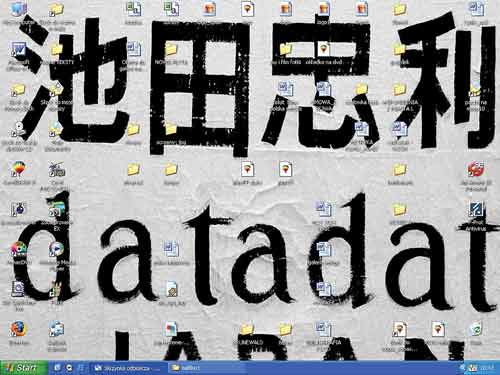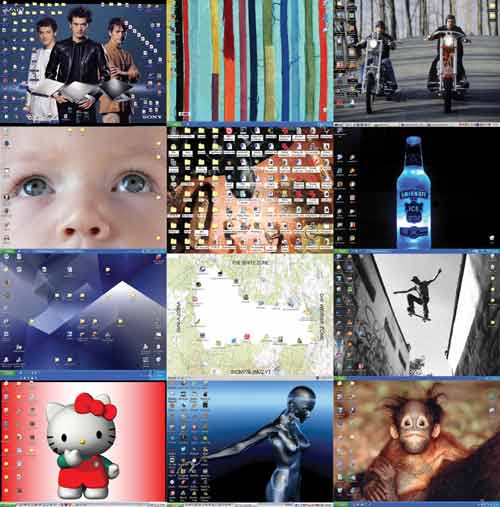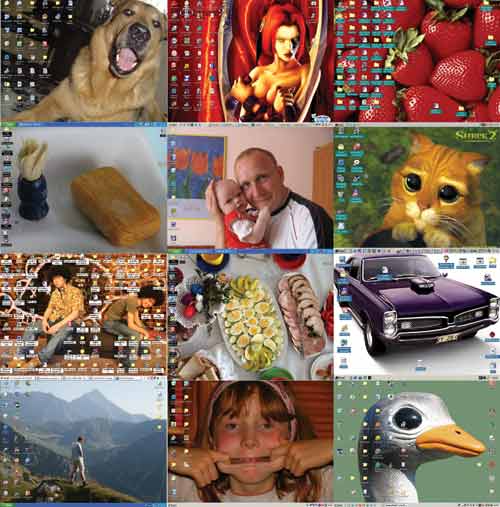

Photography

Photography
is a project based on the medium of photography as
a means of artistic expression and on the Internet as
a means of global communication.
I am especially interested in the following three aspects of this project:
1. "A social and psychological aspect" - today we sit no more most often at the table or on the bed (like in Zofia Rydet's photographs), but behind a desk, at a computer. Photographs of places we dream of, memories..., people we love - nowadays we rarely place them in frames on the desk, we rather transfer them onto a computer screen. The ways in which we place the icons on the screen may also be revealing as to our personality. Briefly speaking: "Show me your screen and I will tell you who you are".
2. Next comes the aspect of the essence of photography as the means of imagery and communication - what was photography once (when it was conceived as the faithful copy of reality which reflects the truth about the world) - and what is photography now, in the era of digital mastering or even digital image production? What and why has modified our understanding and reception of the photographic image? What is, for example, the difference between a photograph of the computer screen and the so-called screen transference, initiated by means of the print screen key, if we record the image in JPEG and print it on PHOTOGRAPHIC paper? Instead of visiting people with a camera and photographying their monitor screens, I ask them to send me e-mails with pictures of their screens. But are we still talking about photography?
3. The third aspect I find significant has to do with the concept of the global village and its multicultural character in the era of rapid development of the Internet which allows artists to change the so-called recipients or consummers of art into its actual subjects, co-authors, and make them participate in their projects.
I am especially interested in the following three aspects of this project:
1. "A social and psychological aspect" - today we sit no more most often at the table or on the bed (like in Zofia Rydet's photographs), but behind a desk, at a computer. Photographs of places we dream of, memories..., people we love - nowadays we rarely place them in frames on the desk, we rather transfer them onto a computer screen. The ways in which we place the icons on the screen may also be revealing as to our personality. Briefly speaking: "Show me your screen and I will tell you who you are".
2. Next comes the aspect of the essence of photography as the means of imagery and communication - what was photography once (when it was conceived as the faithful copy of reality which reflects the truth about the world) - and what is photography now, in the era of digital mastering or even digital image production? What and why has modified our understanding and reception of the photographic image? What is, for example, the difference between a photograph of the computer screen and the so-called screen transference, initiated by means of the print screen key, if we record the image in JPEG and print it on PHOTOGRAPHIC paper? Instead of visiting people with a camera and photographying their monitor screens, I ask them to send me e-mails with pictures of their screens. But are we still talking about photography?
3. The third aspect I find significant has to do with the concept of the global village and its multicultural character in the era of rapid development of the Internet which allows artists to change the so-called recipients or consummers of art into its actual subjects, co-authors, and make them participate in their projects.
Zbigniew Sejwa


Screenphotography
Zbigniew Sejwa is a hunter. Hunter of traces of signs and structures. Those forgotten automatically and those hidden on purpose. He uses the medium of photography and techniques related to photography. However, the poetics of his art occupies a territory which from the point of view of literature - or rather poetry - is admittedly philosophical but densely strewn with literary tropes also called "figures" - such as the metaphore and its numerous variants.
I have been following Sejwa's artistic propositions for years now and I have taken my time arriving at the above conclusions - as if they have formed a kind of a palimpsest all by themselves. The first series of his works I recall is Fragments of Memory from 1994, a kind of installation - or a collage of various trifle objects from the author's own past. The next proposition - from 1996 - called Traces of Common People is a move away from self-analysis to existential reflections on a global scale. In this project the hunt for traces of the presence of the absent was meant to reveal individual features of all people and events recalled. The only obstacle here was the fragility and transitoriness of matter.
This philosophical problem seems to have strongly inspired the artist's imagination since his next series (The Reliquary, 1998) is an attempt at registering and preserving the fleeting, whimsical moment: it consists of photographic portraits of friends and acquaintances of the author, imprisoned in glass jars (normally used for collecting medical specimens but also used at home as air-tight jars for home-made jam and other such preserves), filled with formalin-like liquid. This series was an attempt at experiencing the impossible. That it was doomed to fail, Sejwa's next series proves, called Homo clonus (2000), which centres around the notions of unification and universalization as the diagnosis of the status quo, the condition of contemporary man.
Sejwa's works that took part in the two editions of the international project called The Dialogue of Things (2001) and Dialogue Loci (2004) were an attempt at returning to an optimistic assumption which holds that colourful individualism exists and that variety (conceived as uniqueness) is one of the most significant values of our culture.
The current presentation of the Screenphotography series is a consequence of Sejwa's earlier works. This time the artist visits the fields of technology (high-tech), pop-culture and modern means of communication in order to find that individualism clearly manifests itself in the choices we all make and in visual creations like "screen savers" of our computer screens, with icons in the foreground. En passant Sejwa proves that through what is "hidden" (the graphic convention used, type and object of the photograph, the choice of the level of the transposition etc.) a delicate and fragile truth about us is revealed (by way of personal creation or by pure chance?). Each image is our own and unique. The screen saver becomes like a face. A face as such or perhaps as "that other face" we wear whenever we want to...? Here is where an boundless field for intellectual speculation opens.
The project entitled Screenphotography is also the result of the artist's reflections on the genetics of new art, especially on the tools and language of photographic art. One fundamental doubt is troubling here: is the "screen saver image" on a computer screen photography? Or perhaps photography is rather a "photograph" taken by means of a camera and printed (developed?). Debates whether photography as a medium does or does not belong to fine arts were still loudly going on not long ago. Today those doubts have been shifted into "the depths" of the problem and they concern details. We could observe a similar shift take place earlier in such basic branches of art like painting, drawing, graphics or sculpture. And since some of those doubts remain unsolved to this day, it is small wonder that photography still has a long way way to go in terms of its methodology.
I have been following Sejwa's artistic propositions for years now and I have taken my time arriving at the above conclusions - as if they have formed a kind of a palimpsest all by themselves. The first series of his works I recall is Fragments of Memory from 1994, a kind of installation - or a collage of various trifle objects from the author's own past. The next proposition - from 1996 - called Traces of Common People is a move away from self-analysis to existential reflections on a global scale. In this project the hunt for traces of the presence of the absent was meant to reveal individual features of all people and events recalled. The only obstacle here was the fragility and transitoriness of matter.
This philosophical problem seems to have strongly inspired the artist's imagination since his next series (The Reliquary, 1998) is an attempt at registering and preserving the fleeting, whimsical moment: it consists of photographic portraits of friends and acquaintances of the author, imprisoned in glass jars (normally used for collecting medical specimens but also used at home as air-tight jars for home-made jam and other such preserves), filled with formalin-like liquid. This series was an attempt at experiencing the impossible. That it was doomed to fail, Sejwa's next series proves, called Homo clonus (2000), which centres around the notions of unification and universalization as the diagnosis of the status quo, the condition of contemporary man.
Sejwa's works that took part in the two editions of the international project called The Dialogue of Things (2001) and Dialogue Loci (2004) were an attempt at returning to an optimistic assumption which holds that colourful individualism exists and that variety (conceived as uniqueness) is one of the most significant values of our culture.
The current presentation of the Screenphotography series is a consequence of Sejwa's earlier works. This time the artist visits the fields of technology (high-tech), pop-culture and modern means of communication in order to find that individualism clearly manifests itself in the choices we all make and in visual creations like "screen savers" of our computer screens, with icons in the foreground. En passant Sejwa proves that through what is "hidden" (the graphic convention used, type and object of the photograph, the choice of the level of the transposition etc.) a delicate and fragile truth about us is revealed (by way of personal creation or by pure chance?). Each image is our own and unique. The screen saver becomes like a face. A face as such or perhaps as "that other face" we wear whenever we want to...? Here is where an boundless field for intellectual speculation opens.
The project entitled Screenphotography is also the result of the artist's reflections on the genetics of new art, especially on the tools and language of photographic art. One fundamental doubt is troubling here: is the "screen saver image" on a computer screen photography? Or perhaps photography is rather a "photograph" taken by means of a camera and printed (developed?). Debates whether photography as a medium does or does not belong to fine arts were still loudly going on not long ago. Today those doubts have been shifted into "the depths" of the problem and they concern details. We could observe a similar shift take place earlier in such basic branches of art like painting, drawing, graphics or sculpture. And since some of those doubts remain unsolved to this day, it is small wonder that photography still has a long way way to go in terms of its methodology.
Gabriela Balcerzakowa, September 2005
Translation by Maciej ¦wierkocki
Translation by Maciej ¦wierkocki
Copyright ©2006 Galeria FF £DK, Zbigniew Sejwa, Gabriela Balcerzakowa.